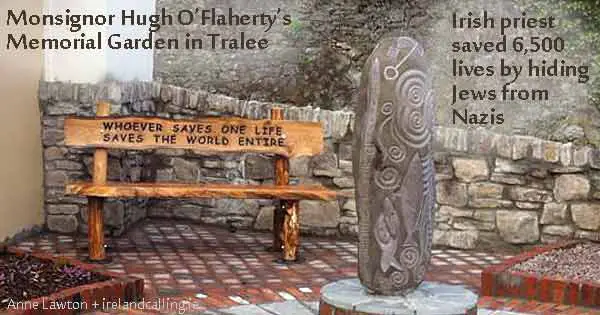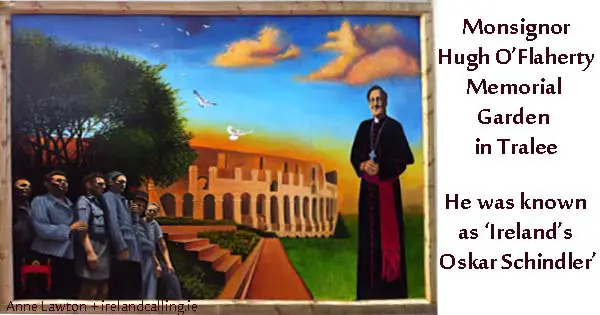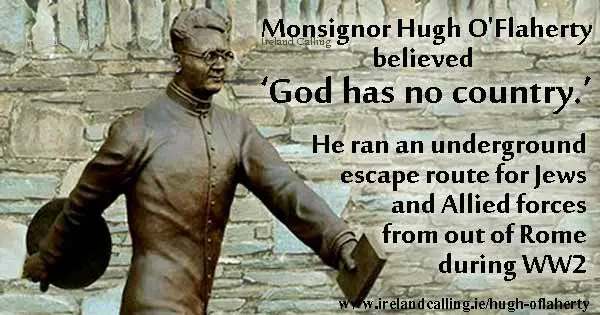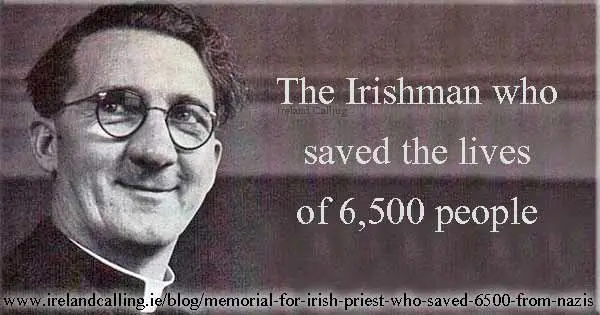Monsignor Hugh O’Flaherty was an Irish priest who is credited with saving more than 6,000 lives after he helped Jews and Allied soldiers hide from the Nazis during World War II.
O’Flaherty hid thousands of people in various farms, church houses and homes around Italy, risking his own life in the process.
He has since been honoured for his brave actions, and his story has been made into a film.
O’Flaherty was born in Killarney in 1898. He grew up on a golf course in Cork, where his father worked.
He joined Mungret College in County Limerick in 1918 to study for the priesthood. Once qualified, O’Flaherty was sent to Rome to work as a Vatican diplomat.
He travelled the world visiting countries such as Haiti, Egypt and Czechoslovakia.
In the early years of the Second World War, O’Flaherty travelled around Europe visiting Prisoner of War camps.
Thousands were at risk of being captured by Nazis
He was in Italy at the time of the collapse of the Mussolini Empire. Thousands of Prisoners of War were released but at risk of being recaptured by the Germans who had taken control of the country.
Many remembered O’Flaherty from his visits to the camps and made their way to Rome to ask him for help in escaping the Nazi regime in Italy.
O’Flaherty organised safe houses for thousands. He hid people in farm buildings, church houses and hundreds of private homes in Italy.
He had a network of people helping him. Delia Murphy, the wife of the Irish ambassador, and Major Sam Derry, an escaped British Prisoner of War were two of O’Flaherty’s key allies.
They also hid Jewish people from the Nazis in the same way. Colonel Herbert Kappler was the head of police in Rome.
He was a Nazi and was tasked with capturing any Italian Jews and transporting them to Auschwitz for execution. Kappler was ruthlessly efficient at this job.
O’Flaherty and his associates managed to transport and hide thousands of people in Italy.

Threat of torture and execution
The Nazis knew about this network of deception and knew that a priest was behind it. They kept a close watch on the Vatican, until they eventually discovered that O’Flaherty was the one concealing Jews.
However, he continued to organise the massive operation of hiding people. He knew that he was safe when in the Vatican, as the Nazis could not kill him there.
O’Flaherty was wanted by the Nazis. Kappler ordered a white line painted on the pavement at the opening of St. Peter’s Square to mark the border of the Vatican City and Italy.
Nazi soldiers were under instructions to execute O’Flaherty on site if he crossed the line.
Ludwig Koch of the Italian police vowed that should O’Flaherty ever end up in his custody, he would not only be executed but also tortured beforehand.
‘Scarlet Pimpernel of the Vatican’
Several unsuccessful attempts were made on O’Flaherty’s life, but he was not deterred. Despite this severe intimidation, O’Flaherty continued his work. He met his associates on the safe ground of the Vatican when possible, and wore disguises on the occasions he had to venture out.
His ability to evade capture earned him the nickname of ‘Scarlet Pimpernel of the Vatican’.
O’Flaherty kept this up for two years before the Allied Forces finally took control of Italy. When they arrived, there were 3,925 Prisoner of War escapees hiding in O’Flaherty safe houses.
Thousands of Jews were also in his care. It is estimated that O’Flaherty and his allies saved the lives of six and a half thousand people.
Once the war had ended, O’Flaherty stressed that Nazi prisoners should be treated properly and humanely by the Allied Forces.

Baptised the man who had wanted him dead
In the following years, he was honoured with numerous awards for his actions. He continued with his humanitarian work and visited prisoners around Europe.
This led to a remarkable friendship between O’Flaherty and the man that had once wanted him dead, former Nazi head of police Colonel Herbert Kappler.
O’Flaherty visited him once a month in jail for several years, and the two men became close friends. In 1959, Kappler converted to Catholicism and was baptised by O’Flaherty.
A year later, O’Flaherty suffered a stroke during a mass. His health deteriorated and he returned to Ireland to live with his sister. He died in 1965.
This is a statue of O’Flaherty in his home town of Killarney, to honour him for his bravery in saving so many lives.

Christabel Burton – Anglo Irish woman who defied the Nazis
